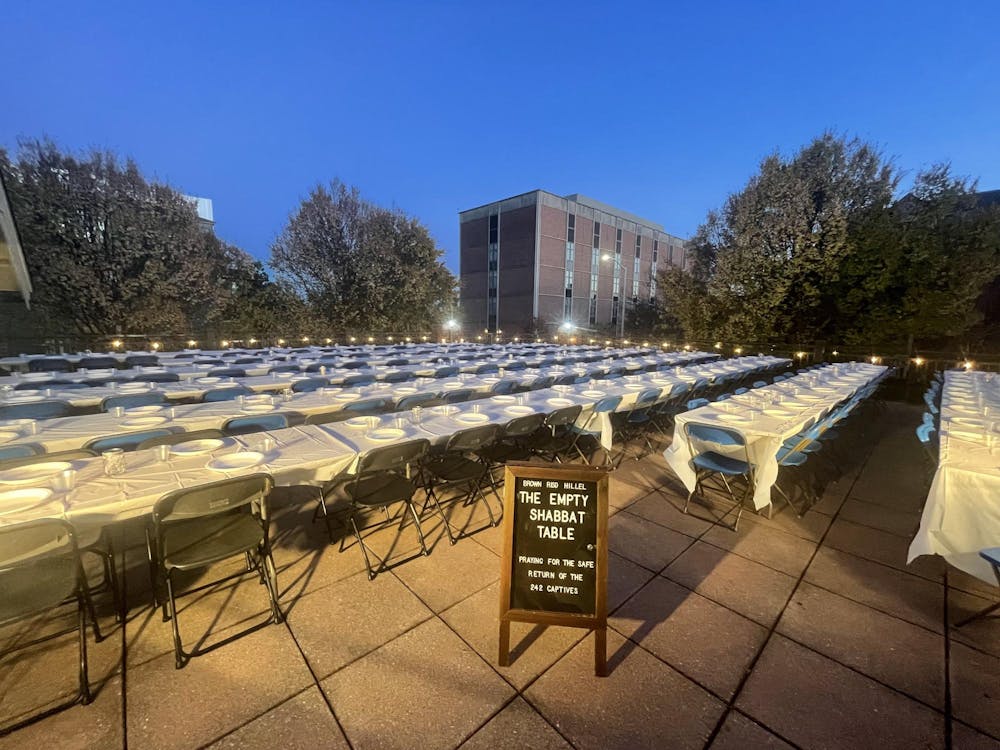Two-hundred and forty-two empty chairs at Shabbat tables dressed with white cloth, plates and cups were set up on the terrace of Brown-RISD Hillel from Nov. 2 to Nov. 6. The installation, titled “The Empty Shabbat Table,” represented “the 242 captives that are being held hostage by Hamas in Gaza,” said Hillel Executive Director and Rabbi Josh Bolton.
“What I feel this exhibit is doing is realizing the humanity of what is going on in Israel and Gaza,” said Daniel Solomon ’26, chair of Brown’s ad-hoc student organizing committee on antisemitism and an organizer of the installation. Solomon hopes that the installation will encourage people to “understand the … incredible loss that our community is facing following October 7.”
Bolton described the installation as “invitational, not confrontational,” and “something that taps into the empathetic spirit of humans.”
“We all need permission to experience the brokenness, the loss, the pain, the sadness, the fear,” he said. “We want to make sure that we provide a place for students to process, to hold themselves and each other.”
According to Bolton, the project was brought forth by “a network of Jewish students” and Hillel staff who “designed and envisioned the installation collectively.”
“We really sought inspiration from the American Jewish Committee installation in Times Square,” Solomon said. “We were very fortunate to have had the partnership with the American Jewish Committee and their staff in bringing this idea to fruition.”
Solomon — a former staffer at AJC — worked with the organization, which “provided resources, financial counsel (and) logistical support,” he said.
“Above all, this installation is for students who are grieving and (to) give students the opportunity to be together in this incredibly challenging time,” Solomon added, emphasizing advocacy for the return of the hostages kept by Hamas.
“We felt it very important to send a very clear message,” Solomon said. “We want our hostages home.”
Hamas, the militant group that controls much of the Gaza Strip, launched attacks by land, air and sea on several cities across southern and central Israel on Oct. 7, the Associated Press reported, during which they took an estimated 242 people hostage.
Hamas has released four hostages since its initial attack in October, but the rest of the hostages — who hail from more than 40 countries — were still held in captivity as of Nov. 7.
Since then, the Israeli military has retaliated with continual strikes on Gaza, a ground invasion and an escalation of their decades-long blockade, which Israeli officials have said will not pause for humanitarian aid until the hostages are released.
Around 1,400 Israelis were killed in the Hamas attack. Israeli military retaliation has killed over 10,300 Palestinians, the Associated Press reported. United Nations experts have warned of a "grave risk of genocide" for Palestinians in Gaza.
In Israel, support for a prisoner exchange deal has grown, a call that has initially been rebuffed by the Israeli government.
According to Solomon, organizers had the idea of putting up the installation “since the onset of the Israel-Hamas war.” Similar installations have been put up nationally and around the world, he added.
“This kind of evolved organically,” Bolton said. “This is something that is happening in different types of shapes and forms.”
Although the idea of the empty Shabbat tables was not unique to Brown, Solomon said that Hillel’s specific installation “captured the Brown spirit.”
According to Solomon, the project took just over a week to complete. “It’s an incredibly emotional process,” Solomon said. “Setting up a Shabbat table that we know will not be filled.”
Gigi Goldfischer ’25, who helped with setting up the tables, said that remembering that every empty place setting represented “a real person” made the experience “very impactful and emotional.”
“By proximity, we’re forced to confront this, to be face-to-face with this display,” Goldfischer said, explaining that various community members use the space and that people walking by Hillel can see the tables. “It’s right there … and there are so many empty seats.”
On Friday evening, after the tables were set up Thursday afternoon, around 250 students celebrated Shabbat at Hillel, Bolton said. “This parallelism — on the one hand, the joy, noise, the life in the social hall, (and) on the other hand, the silence of this other community on the terrace — that’s very powerful,” he explained.
“We experience … the profound sense of absence, the silence” of the empty tables, Bolton said.
According to Bolton, some students have tried to experience “the quietness” of the installation, while others took photos. “There’s a way in which the installation travels through friends and parents and (the) alumni network,” he said.
The installation “is a visual depiction of the 240 souls that we are grieving” for, Solomon said. “We hope they know we are thinking about them. … We hope for their return home.”

Kathy Wang was the senior editor of community of The Brown Daily Herald's 134th Editorial Board. She previously covered student government and international student life as a University News editor. When she's not at The Herald, you can find her watching cooking videos or writing creative nonfiction.





